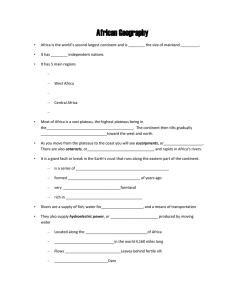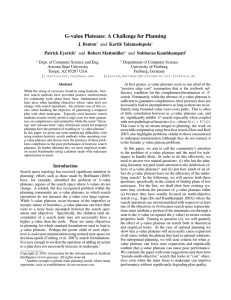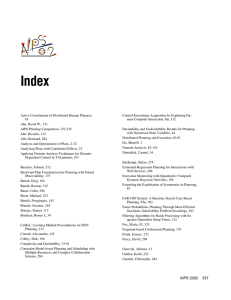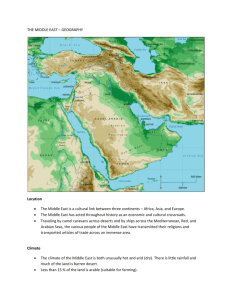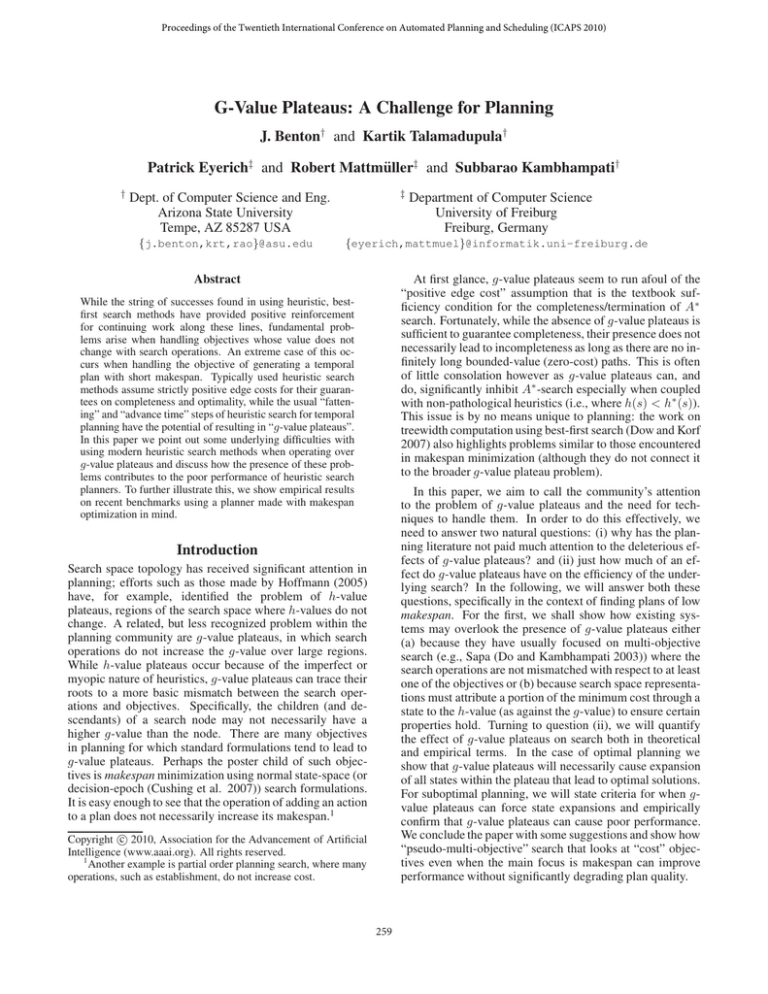
Proceedings of the Twentieth International Conference on Automated Planning and Scheduling (ICAPS 2010)
G-Value Plateaus: A Challenge for Planning
J. Benton† and Kartik Talamadupula†
Patrick Eyerich‡ and Robert Mattmüller‡ and Subbarao Kambhampati†
†
‡
Dept. of Computer Science and Eng.
Arizona State University
Tempe, AZ 85287 USA
{j.benton,krt,rao}@asu.edu
Department of Computer Science
University of Freiburg
Freiburg, Germany
{eyerich,mattmuel}@informatik.uni-freiburg.de
At first glance, g-value plateaus seem to run afoul of the
“positive edge cost” assumption that is the textbook sufficiency condition for the completeness/termination of A∗
search. Fortunately, while the absence of g-value plateaus is
sufficient to guarantee completeness, their presence does not
necessarily lead to incompleteness as long as there are no infinitely long bounded-value (zero-cost) paths. This is often
of little consolation however as g-value plateaus can, and
do, significantly inhibit A∗ -search especially when coupled
with non-pathological heuristics (i.e., where h(s) < h∗ (s)).
This issue is by no means unique to planning: the work on
treewidth computation using best-first search (Dow and Korf
2007) also highlights problems similar to those encountered
in makespan minimization (although they do not connect it
to the broader g-value plateau problem).
Abstract
While the string of successes found in using heuristic, bestfirst search methods have provided positive reinforcement
for continuing work along these lines, fundamental problems arise when handling objectives whose value does not
change with search operations. An extreme case of this occurs when handling the objective of generating a temporal
plan with short makespan. Typically used heuristic search
methods assume strictly positive edge costs for their guarantees on completeness and optimality, while the usual “fattening” and “advance time” steps of heuristic search for temporal
planning have the potential of resulting in “g-value plateaus”.
In this paper we point out some underlying difficulties with
using modern heuristic search methods when operating over
g-value plateaus and discuss how the presence of these problems contributes to the poor performance of heuristic search
planners. To further illustrate this, we show empirical results
on recent benchmarks using a planner made with makespan
optimization in mind.
In this paper, we aim to call the community’s attention
to the problem of g-value plateaus and the need for techniques to handle them. In order to do this effectively, we
need to answer two natural questions: (i) why has the planning literature not paid much attention to the deleterious effects of g-value plateaus? and (ii) just how much of an effect do g-value plateaus have on the efficiency of the underlying search? In the following, we will answer both these
questions, specifically in the context of finding plans of low
makespan. For the first, we shall show how existing systems may overlook the presence of g-value plateaus either
(a) because they have usually focused on multi-objective
search (e.g., Sapa (Do and Kambhampati 2003)) where the
search operations are not mismatched with respect to at least
one of the objectives or (b) because search space representations must attribute a portion of the minimum cost through a
state to the h-value (as against the g-value) to ensure certain
properties hold. Turning to question (ii), we will quantify
the effect of g-value plateaus on search both in theoretical
and empirical terms. In the case of optimal planning we
show that g-value plateaus will necessarily cause expansion
of all states within the plateau that lead to optimal solutions.
For suboptimal planning, we will state criteria for when gvalue plateaus can force state expansions and empirically
confirm that g-value plateaus can cause poor performance.
We conclude the paper with some suggestions and show how
“pseudo-multi-objective” search that looks at “cost” objectives even when the main focus is makespan can improve
performance without significantly degrading plan quality.
Introduction
Search space topology has received significant attention in
planning; efforts such as those made by Hoffmann (2005)
have, for example, identified the problem of h-value
plateaus, regions of the search space where h-values do not
change. A related, but less recognized problem within the
planning community are g-value plateaus, in which search
operations do not increase the g-value over large regions.
While h-value plateaus occur because of the imperfect or
myopic nature of heuristics, g-value plateaus can trace their
roots to a more basic mismatch between the search operations and objectives. Specifically, the children (and descendants) of a search node may not necessarily have a
higher g-value than the node. There are many objectives
in planning for which standard formulations tend to lead to
g-value plateaus. Perhaps the poster child of such objectives is makespan minimization using normal state-space (or
decision-epoch (Cushing et al. 2007)) search formulations.
It is easy enough to see that the operation of adding an action
to a plan does not necessarily increase its makespan.1
c 2010, Association for the Advancement of Artificial
Copyright Intelligence (www.aaai.org). All rights reserved.
1
Another example is partial order planning search, where many
operations, such as establishment, do not increase cost.
259
Case Study: Minimizing Makespan
It can be shown that typical temporal state-space planners
working to optimize makespan can suffer from plateaus over
the objective function. However, this fact may be overlooked
at first glance due to their state space models and how they
attribute h- and g-values. We present an evaluation of current approaches that shows how plateaus over the objective
function can appear.
Figure 1: A state s in a (progression) temporal heuristic
search planner.
Temporal Planning Background
Many existing forward and regression heuristic search temporal planners use a decision epoch time point as their gvalue.2 In usual forward chaining search methods (Bacchus and Ady 2001; Do and Kambhampati 2003; Eyerich, Mattmüller, and Röger 2009), this is the “current
time” for actions to begin execution; the regression planner TP4 (Haslum and Geffner 2001), on the other hand, uses
a different style of search where the g-value represents the
time from the goal to a state’s decision epoch. This entails
keeping time points of where “currently executing” actions
end (progression) or begin (regression). In the following, we
call these action time points to simplify discussion.
actions in parallel with useful ones without changing the final plan makespan, leading to g-value plateaus. Informally,
g-value plateaus are a tree structure within the search space
where the evaluation values of states do not change from ancestor to descendant. They are inherently local in nature.
We discuss plateaus on g in both the optimal and suboptimal
contexts but first give them a more formal definition.
Definition 1. A g-value plateau with respect to state s is the
partial subtree T [s] where s is the root and T [s] includes all
immediate descendants s where g(s) = g(s ) and all states
in the g-value plateau T [s ].
State Evaluation
In the worst case, when all states in the g-value plateau
T [s] have a constant heuristic value, upon expanding a state
s, A∗ will eventually expand all states s ∈ T [s]. This implies that better heuristics or tie-breaking rules may significantly improve matters. It turns out that this is not always
enough. In optimal planning, multiple paths to equally valued states can cause expansion of large portions of the gvalue plateau.
A usual problem for makespan optimization in state space
temporal planning relates to adding long actions that must
run in parallel with a series of shorter actions to obtain a
high quality solution. Often in these cases, many permutations of the shorter actions can be considered. That is,
there is long action giving a constant minimum bound on
the makespan for a state, a value different than the current decision epoch time point. In the usual A∗ evaluation function of f (s) = g(s) + h(s) for a state s, this
constant bound can be on either g(s) or h(s). In terms
of the discussed planning methods, we call the decision
epoch gt (s) (with a corresponding heuristic ht (s)) and distinguish it from the known minimum makespan, which we
call gm (s). More formally, given a state s and a maximum
distance action time point from gt (s), tmax (s) we define
gm (s) = max(gt (s), tmax (s)) (see Figure 1). Note that we
cannot (and should not) easily use this view of state evaluation in practice, as it can produce complications in representing the state space (for instance, hm (s) = 0 is not
enough for a goal test). Ultimately, since ht (s) defines a
minimum value that can be found with constant computational time, we can perform this transfer of values from h to
g. For this reason the transfer serves to simplify discussion
and analysis to considering only g-value plateaus whenever
such minimum bounds exist in the calculation of h.
Theorem 1. Given a g-value plateau T [s] (of a state s) that
does not contain a goal state and an admissible but nonpathological heuristic function h, upon expanding s during
the search, A∗ will eventually expand all state s ∈ T [s]
before reaching a goal state, where T [s] ⊆ T [s] \ {s} is the
set of states that can be expanded to an optimal path.
Proof. Let g ∗ be the optimal solution value. For any state
s ∈ T [s]: h∗ (s) = h∗ (s ), since g(s) + h∗ (s) = g(s ) +
h∗ (s ) = g ∗ and g(s) = g(s ). As h is an admissible and
non-pathological heuristic function, h(s ) < h∗ (s ) which
implies f (s ) = g(s ) + h(s ) = g(s) + h(s ) < g(s) +
h∗ (s ) = g(s) + h∗ (s) = g ∗ . Therefore, A* must expand s
before finding an optimal solution.
A similar problem also occurs in the case of finding
suboptimal plans using any heuristic (e.g., inadmissible or
weighted heuristics) in the A∗ framework. Specifically, we
can characterize a portion of the g-value plateau that must
be explored.
Plateaus on g
Proposition 1. Consider a path P = (s0 , . . . , sg ) from
an initial state s0 to a solution state sg found with an
A∗ search using an (inadmissible) heuristic h. Let si be
a state in the path such that its g-value plateau, T [si ],
does not contain sg , sj (j > i) be the first state s.t.
g(sj ) > g(si ) (and therefore is outside the plateau), and
smax = arg maxs∈(sj ,...,sg ) {f (s)}. Then, upon expanding
In temporal planning problem benchmarks, adjacent search
states with equal makespan (as defined by gm ) can occur in
abundance since it is often possible to execute extraneous
2
We are focusing on planners that handle temporally “simple”
models, i.e., those that cannot generally handle problems with required concurrency.
260
si , before reaching the goal state A∗ will have eventually
expanded all states s in the plateau that can be reached
from si through at least one path with all states s s.t.
f (s ) < fmax = f (smax ).
Steps Toward a Solution
By now we have accomplished the main aim of this paper,
which is to bring the challenge to the foreground. In this section, we discuss steps towards handling this challenge and
share results on one promising idea.
The problem with g-value plateaus is that they can induce
search that is worse than standard breadth-first search, a phenomenon that can occur in A∗ search with any non-uniform
cost values on transitions. g-value plateaus may be seen as a
special case of this and offer a step in identifying such “problem” regions of the search space. For instance, one possibility of handling these situations is to find “exit points” to
any state beyond the g-value plateau. While it is generally
impossible to know fmax , we can at least identify g-value
plateaus, areas we know have strong dependency on the behavior of the heuristic. In particular, we consider finding
a set of exit points that are diverse in their potential reachability across a plateau (c.f., Srivastava et al. (2007)). Of
course, such techniques would likely need to be anytime in
nature for complete and optimal planning.
Another possibility is to try to remove the plateaus by
using equivalence classes between states. Such analysis
would likely be domain-dependent but if done properly may
collapse g-value plateaus. Related to this, in planning for
makespan, we can consider using causal analysis to avoid
adding extraneous actions. However, this is impractical in
general (though approximation methods may be used).
One may consider the idea of adding a small increase
in g-values between a parent and child when there would
otherwise be zero cost. Indeed, this approach has been applied in the case of planning with action costs (Richter and
Westphal 2008; Keyder and Geffner 2008; Benton, Do, and
Kambhampati 2009). However, this is unlikely to succeed
in general cases. Small increases, given a large enough
fmax , would exhibit the same behavior. Instead, we study
techniques inspired by Sapa and Temporal Fast Downward
(TFD) in the temporal planning setting. These planners
found success when performing “pseudo-multi-objective”
searches.
We developed an approach that applies an additional
heuristic cost related both to the makespan (the objective
function with g-value plateaus) and the number of search
operations left. Specifically, we apply a weighted “cost”
heuristic value, hc (s), which sums the durations of hm (s)
(i.e., the “makespan-to-go”) and use the evaluation function gm (s) + hm (s) + w ∗ hc (s). As we will see next,
this technique finds some success. The solution differs from
those of Sapa and TFD in that we include a state evaluation
over makespan while adding a cost evaluation on duration,
whereas Sapa uses makespan to calculate its fundamentally
cost-based heuristic and TFD only uses the sum of durations
as an estimate of makespan. From this perspective the technique is more related to the revised dynamically weighted
A∗ approach by Thayer and Ruml (2009). While such techniques improve performance, they may not work well in every domain with g-value plateaus, such as problems with
known solution depths (for example, best-first search for
treewidth (Dow and Korf 2007)).
Proof. As all the states s along the path from si to s satisfy
f (s ) < fmax , they will be pulled off the queue before the
state smax .
This proposition implies that there is a portion of the gvalue plateau with states s where h(s) < hmax = fmax −
g(si ) that eventually must be explored. In other words, the
heuristic function must return a value greater than the bound
hmax in order to prune this search space, underscoring that
only the h-value can guide search over g-value plateaus.
Empirical Confirmation
We designed experiments to analyze the search spaces of
recent temporal planning benchmark problems for g-value
plateaus on makespan. To enable this analysis, we designed
a new (inadmissible) makespan heuristic (hm ) on top of the
context-enhanced additive heuristic used in the Temporal
Fast Downward (TFD) planner (Eyerich, Mattmüller, and
Röger 2009).
The heuristic uses the same method as TFD for determining sets of actions required to reach the goal. In the
makespan heuristic we make use of the causal constraints
between actions (assuming TGP semantics (Smith and Weld
1999)) as detected during the extraction of the heuristic
plan. These constraints, together with duration constraints
between when action begin and end points, are encoded in
a Simple Temporal Network (STN). The makespan of the
schedule produced by solving the STN is then returned as
the heuristic estimate.
Table 1 summarizes the results of the empirical analysis
on the 6th International Planning Competition (IPC-2008)
domains. Our experiments were run on an Intel Xeon processor running at 2.66 Ghz at a 10 minute time limit running
using SuSE Linux. Unlike the original TFD, the planner
neither performs an anytime search nor uses “preferred operators”. Note that the values rg and rf in the table include
runs where no solution was found (but a sample of the search
space could still be taken).
We define the function gc (s) as the sum of all action durations chosen at s, hc (s) as the heuristic on the sums of durations on the “actions-to-go”, hm (s) as our new heuristic,
and gm (s) as described previously (i.e., the makespan of s
up to the longest running action). The results show remarkably large portions of the search space with g-value plateaus
on makespan in all domains where fm = gm + hm is used.
Notice that, except in openstacks-adl and openstacks-strips,
f -value plateaus increase significantly with g-value plateaus
(an expected result). Contrasting with fc = gc + hc , it is
apparent that using summed durations improves coverage of
problems solved significantly, though the quality of the solutions is reduced. Note that it is possible to get equal g-values
on parents and children using gc in our search with the “advance time” operation, which does not add any actions.
261
Domain
crewplanning-strips
elevators-numeric
elevators-strips
openstacks-adl
openstacks-strips
parcprinter-strips
pegsol-strips
sokoban-strips
transport-numeric
woodworking-numeric
overall
rg
0.03
0.06
0.07
0.15
0.14
0.16
0.17
0.28
0.23
0.08
0.09
fc = gc + hc
rf
cov
0.55
11
0.03
4
0.05
3
0.89
30
0.88
30
0.08
12
0.09
25
0.16
11
0.06
2
0.12
18
0.21 146
qual
6.82
2.41
1.70
17.80
17.12
5.68
18.77
10.18
1.26
14.30
96.04
rg
0.98
0.57
0.53
1.00
0.67
0.90
0.85
0.78
0.74
0.72
0.84
fm = g m + h m
rf
cov
0.83
4
0.27
2
0.25
3
0.88
8
0.29
27
0.37
6
0.25
22
0.32
10
0.48
3
0.26
18
0.50 103
qual
4.00
2.00
2.98
7.58
20.93
5.31
21.15
10.00
3.00
16.91
93.86
rg
0.95
0.48
0.44
0.92
0.71
0.76
0.82
0.77
0.58
0.55
0.68
fmw = gm + hw
rf
cov
qual
0.09
12
11.99
0.05
4
3.78
0.04
4
3.92
0.02
30
28.00
0.06
30
25.39
0.09
6
5.00
0.08
26
24.04
0.10
10
9.83
0.09
3
2.78
0.04
19
17.64
0.07 144 132.37
Table 1: A comparison of the aggregate fraction of zero-cost search operations (rg ), the fraction of f -valued children with equal
value to parent (rf ), problems solved (cov) and plan quality according to the IPC-2008 measure (qual, where higher is better
compared against the IPC “reference” plans when available) on the IPC-2008 benchmark domains in the temporal satisficing
track on fc = gc + hc , fm = gm + hm and fmw = gm + hw .
Empirical Evaluation
Systems” (SFB/TR 14 AVACS) and by the EU as part of
the Integrated Project CogX (FP7-ICT-2xo15181-CogX).
In addition to confirming the existence of and problems with
g-value plateaus, we ran experiments to test our simple improvement that combines a makespan and weighted cost
heuristic using hw = hm (s) + 0.2 ∗ hc (s). With these functions we ran A∗ as before but over the evaluation function
fmw (s) = gm (s) + hw (s).
Our experiments on fmw show that, despite the g-value
plateaus that still remain in the search space, performance
improves dramatically from fm (see Table 1). In fact, in
most instances, openstacks-adl in particular, the planner appears to be achieving the best of both worlds, with a high
number of problems solved with high quality (and our total
quality reflects this increase). Also, by adding a weighted
hc , in most cases the search spaces have a significant decrease in f -value plateaus compared with fc and fm .
References
Bacchus, F., and Ady, M. 2001. Planning with resources and concurrency: A forward chaining approach. In Proceedings of the 17th
International Joint Conference on Artificial Intelligence (IJCAI),
417–424.
Benton, J.; Do, M.; and Kambhampati, S. 2009. Anytime heuristic search for partial satisfaction planning. Artificial Intelligence
Journal 173(5-6).
Cushing, W.; Kambhampati, S.; Mausam; and Weld, D. S. 2007.
When is temporal planning really temporal? In Proceedings of the
20th IJCAI, 1852–1859.
Do, M., and Kambhampati, S. 2003. Sapa: A scalable multiobjective metric temporal planner. Journal of Artificial Intelligence
Research (JAIR) 20:155–194.
Dow, P. A., and Korf, R. E. 2007. Best-first search for treewidth.
In Proceedings of the 22nd Conference on Artificial Intelligence.
Eyerich, P.; Mattmüller, R.; and Röger, G. 2009. Using the contextenhanced additive heuristic for temporal and numeric planning. In
Proceedings of the 19th International Conference on Automated
Planning and Scheduling (ICAPS).
Haslum, P., and Geffner, H. 2001. Heuristic planning with time
and resources. In Proceedings of the 6th European Conference on
Planning.
Hoffmann, J. 2005. Where ‘ignoring delete lists’ works: Local
search topology in planning benchmarks. JAIR 24:685–758.
Keyder, E., and Geffner, H. 2008. The FF(ha ) planner for planning
with action costs. In Proceedings of the International Planning
Competition (IPC).
Richter, S., and Westphal, M. 2008. The LAMA planner. using
landmark counting in heuristic search. In Proceedings of the IPC.
Smith, D. E., and Weld, D. S. 1999. Temporal planning with mutual exclusion reasoning. In Proceedings of the 16th IJCAI, 326–
337.
Srivastava, B.; Kambhampati, S.; Nguyen, T.; Do, M.; Gerevini,
A.; and Serina, I. 2007. Domain independent approaches for finding diverse plans. In Proceedings of the 20th IJCAI.
Thayer, J. T., and Ruml, W. 2009. Using distance estimates in
heuristic search. In Proceedings of the 19th ICAPS.
Conclusion
This paper points out the problem of g-value plateaus and
shows how they can lead to poor search performance. We
focused particularly on planning for quality solutions using
makespan as a prime example of where the problem occurs and studied one solution to this problem. Our empirical results show that, when facing g-value plateaus, we can
improve performance significantly using a “pseudo-multiobjective” method that includes a heuristic on a related,
but different objective. However, this approach is not optimal and we believe that techniques that focus on identifying g-value plateaus may yield more principled and general approaches compatible with both optimal and suboptimal search.
Acknowledgments: We extend our thanks to Tuan Nguyen,
William Cushing and Rong Zhou for their helpful discussions. Many thanks also go to Wheeler Ruml, Jordan
Thayer, Sofia Lemons and the anonymous reviewers for
their excellent comments. This research is supported in part
by ONR grants N00014-09-1-0017, N00014-07-1-1049, the
NSF grant IIS-0905672, by the German Research Council
(DFG) as part of the Transregional Collaborative Research
Center “Automatic Verification and Analysis of Complex
262

